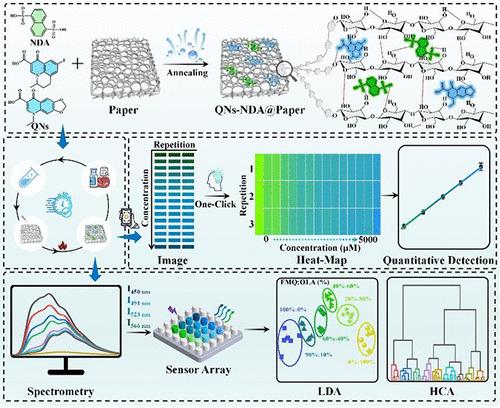人工智能一键处理辅助比率RTP纸基传感器阵列快速鉴别检测氧喹啉酸与氟喹混合物
IF 6.7
1区 化学
Q1 CHEMISTRY, ANALYTICAL
引用次数: 0
摘要
结构类似分析物的快速和精确的检测和区分仍然是非常可取的,但具有挑战性。在这项工作中,开发了一种结合磷光放大和人工智能驱动数据处理的比例室温磷光(RTP)传感器阵列,用于快速鉴别和定量氧喹啉酸(OLA)和氟喹(FMQ)的混合物。传感器阵列利用纸质衬底通过约束和热退火机制放大OLA和FMQ的蓝色RTP信号和1,5-萘二磺酸的绿色RTP信号。将这些放大后的信号与人工智能自动处理、模式识别、量化和判别相结合,在10 min内实现了低至1.96 μM的OLA和FMQ混合。此外,整个过程可以通过使用基于智能手机的摄像头来执行,从而消除了对专用仪器的需求。该传感器阵列在实际样品中也表现出优异的性能,包括环境和食物矩阵,并为创新的传感器设计铺平了道路。本文章由计算机程序翻译,如有差异,请以英文原文为准。

AI One-Click-Processing-Assisted Ratiometric RTP Paper-Based Sensor Array for the Rapid Discrimination and Detection of Mixtures of Oxolinic Acid and Flumequine
The rapid and precise detection and discrimination of structurally analogous analytes remain highly desirable yet challenging. In this work, a ratiometric room-temperature phosphorescence (RTP) sensor array integrated with phosphorescence amplification and artificial intelligence (AI)-driven data processing was developed for the rapid discrimination and quantification of the mixture of oxolinic acid (OLA) and flumequine (FMQ). The sensor array leverages paper substrates to amplify the blue RTP signals of the OLA and FMQ and the green RTP signals of 1,5-naphthalenedisulfonic acid through a confinement and thermal annealing mechanism. By coupling these amplified signals with automated AI processing and pattern recognition, quantification, and discrimination, the mixture of OLA and FMQ was realized, as low as 1.96 μM, within 10 min. In addition, the entire process could be executed by using a smartphone-based camera, eliminating the need for specialized instrumentation. The sensor array also demonstrated exceptional performance in practical samples, including environmental and food matrices, and paved the way for innovative sensor design.
求助全文
通过发布文献求助,成功后即可免费获取论文全文。
去求助
来源期刊

Analytical Chemistry
化学-分析化学
CiteScore
12.10
自引率
12.20%
发文量
1949
审稿时长
1.4 months
期刊介绍:
Analytical Chemistry, a peer-reviewed research journal, focuses on disseminating new and original knowledge across all branches of analytical chemistry. Fundamental articles may explore general principles of chemical measurement science and need not directly address existing or potential analytical methodology. They can be entirely theoretical or report experimental results. Contributions may cover various phases of analytical operations, including sampling, bioanalysis, electrochemistry, mass spectrometry, microscale and nanoscale systems, environmental analysis, separations, spectroscopy, chemical reactions and selectivity, instrumentation, imaging, surface analysis, and data processing. Papers discussing known analytical methods should present a significant, original application of the method, a notable improvement, or results on an important analyte.
 求助内容:
求助内容: 应助结果提醒方式:
应助结果提醒方式:


